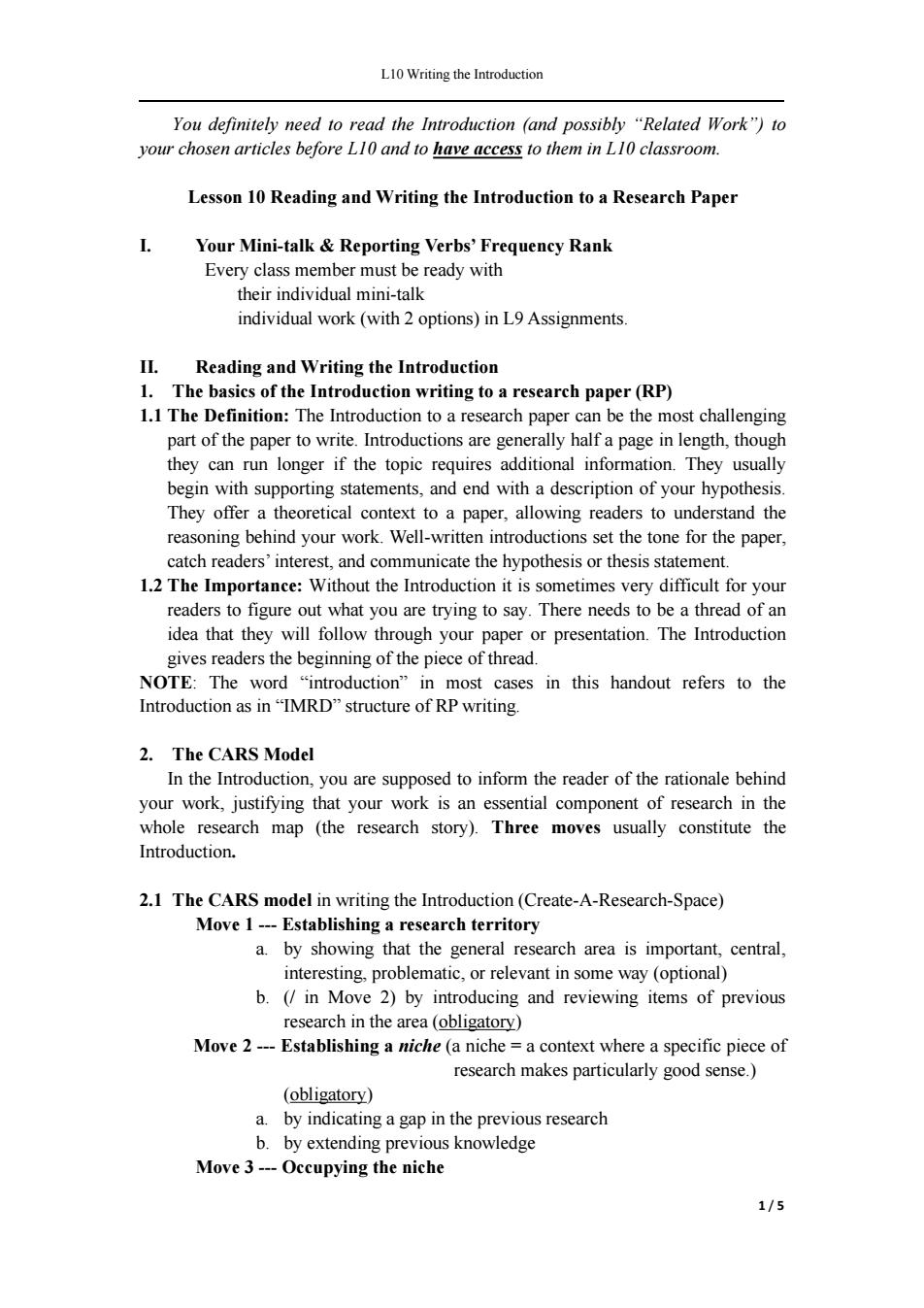
L10 Writing the Introduction You definitely need to read the Introduction (and possibly "Related Work")to your chosen articles before L10 and to have access to them in L10 classroom. Lesson 10 Reading and Writing the Introduction to a Research Paper Your Mini-talk Reporting Verbs'Frequency Rank Every class member must be ready with their individual mini-talk individual work (with 2 options)in L9 Assignments. II.Reading and Writing the Introduction 1.The basics of the Introduction writing to a research paper(RP) 1.1 The Definition:The Introduction to a research paper can be the most challenging part of the paper to write.Introductions are generally half a page in length,though they can run longer if the topic requires additional information.They usually begin with supporting statements,and end with a description of your hypothesis. They offer a theoretical context to a paper,allowing readers to understand the reasoning behind your work.Well-written introductions set the tone for the paper, catch readers'interest,and communicate the hypothesis or thesis statement. 1.2 The Importance:Without the Introduction it is sometimes very difficult for your readers to figure out what you are trying to say.There needs to be a thread of an idea that they will follow through your paper or presentation.The Introduction gives readers the beginning of the piece of thread. NOTE:The word "introduction"in most cases in this handout refers to the Introduction as in"IMRD"structure of RP writing. 2.The CARS Model In the Introduction,you are supposed to inform the reader of the rationale behind your work,justifying that your work is an essential component of research in the whole research map (the research story).Three moves usually constitute the Introduction. 2.1 The CARS model in writing the Introduction(Create-A-Research-Space) Move 1---Establishing a research territory a.by showing that the general research area is important,central, interesting,problematic,or relevant in some way (optional) b.(in Move 2)by introducing and reviewing items of previous research in the area(obligatory) Move 2---Establishing a niche(a niche a context where a specific piece of research makes particularly good sense.) (obligatory) a.by indicating a gap in the previous research b.by extending previous knowledge Move 3---Occupying the niche 1/5
L10 Writing the Introduction 1 / 5 You definitely need to read the Introduction (and possibly “Related Work”) to your chosen articles before L10 and to have access to them in L10 classroom. Lesson 10 Reading and Writing the Introduction to a Research Paper I. Your Mini-talk & Reporting Verbs’ Frequency Rank Every class member must be ready with their individual mini-talk individual work (with 2 options) in L9 Assignments. II. Reading and Writing the Introduction 1. The basics of the Introduction writing to a research paper (RP) 1.1 The Definition: The Introduction to a research paper can be the most challenging part of the paper to write. Introductions are generally half a page in length, though they can run longer if the topic requires additional information. They usually begin with supporting statements, and end with a description of your hypothesis. They offer a theoretical context to a paper, allowing readers to understand the reasoning behind your work. Well-written introductions set the tone for the paper, catch readers’ interest, and communicate the hypothesis or thesis statement. 1.2 The Importance: Without the Introduction it is sometimes very difficult for your readers to figure out what you are trying to say. There needs to be a thread of an idea that they will follow through your paper or presentation. The Introduction gives readers the beginning of the piece of thread. NOTE: The word “introduction” in most cases in this handout refers to the Introduction as in “IMRD” structure of RP writing. 2. The CARS Model In the Introduction, you are supposed to inform the reader of the rationale behind your work, justifying that your work is an essential component of research in the whole research map (the research story). Three moves usually constitute the Introduction. 2.1 The CARS model in writing the Introduction (Create-A-Research-Space) Move 1 --- Establishing a research territory a. by showing that the general research area is important, central, interesting, problematic, or relevant in some way (optional) b. (/ in Move 2) by introducing and reviewing items of previous research in the area (obligatory) Move 2 --- Establishing a niche (a niche = a context where a specific piece of research makes particularly good sense.) (obligatory) a. by indicating a gap in the previous research b. by extending previous knowledge Move 3 --- Occupying the niche
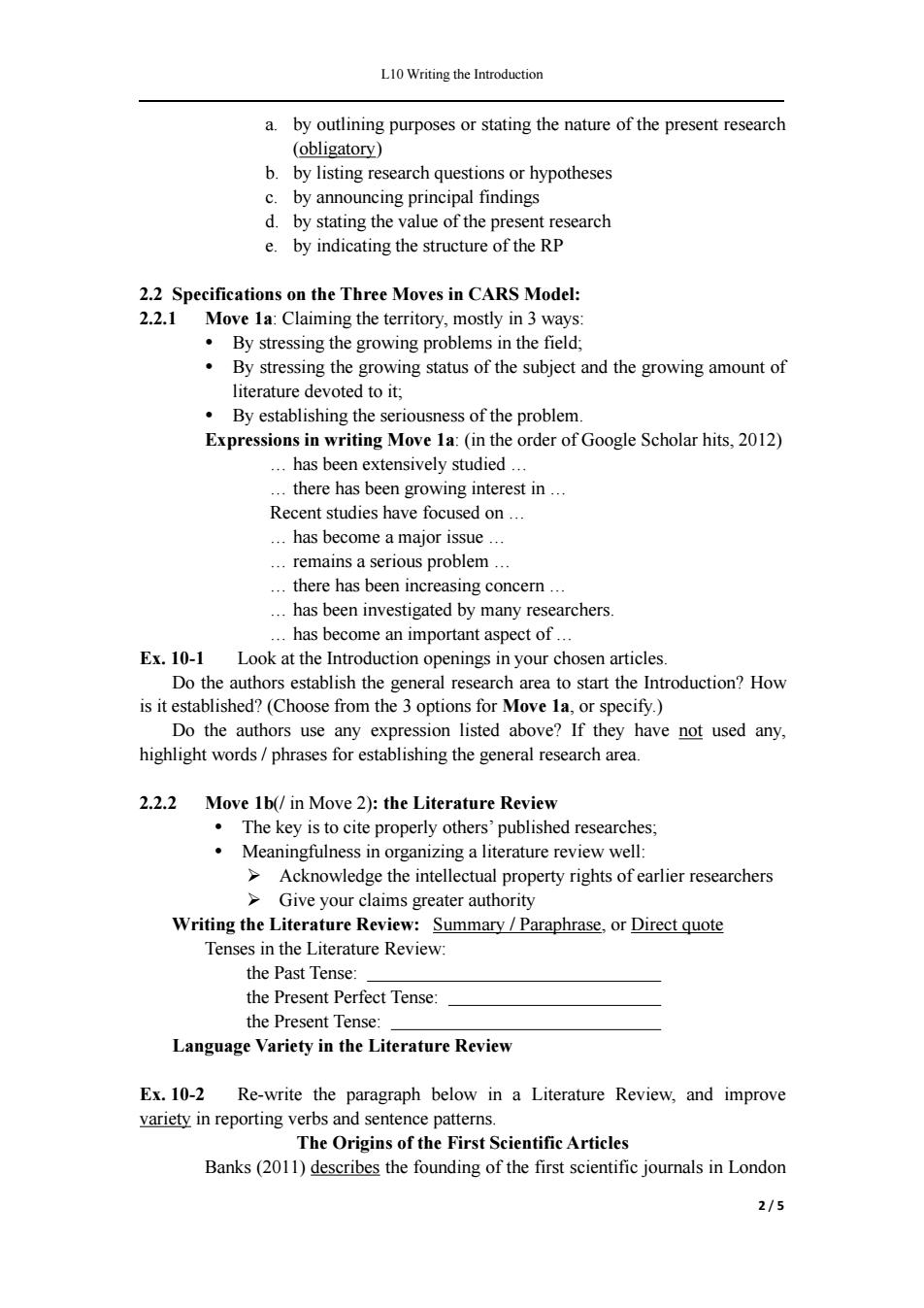
L10 Writing the Introduction a.by outlining purposes or stating the nature of the present research (obligatory) b.by listing research questions or hypotheses c.by announcing principal findings d.by stating the value of the present research e.by indicating the structure of the RP 2.2 Specifications on the Three Moves in CARS Model: 2.2.1 Move 1a:Claiming the territory,mostly in 3 ways: By stressing the growing problems in the field; By stressing the growing status of the subject and the growing amount of literature devoted to it; By establishing the seriousness of the problem Expressions in writing Move 1a:(in the order of Google Scholar hits,2012) ..has been extensively studied... ..there has been growing interest in... Recent studies have focused on... ..has become a major issue... ..remains a serious problem... ..there has been increasing concern... ..has been investigated by many researchers. ..has become an important aspect of... Ex.10-1 Look at the Introduction openings in your chosen articles. Do the authors establish the general research area to start the Introduction?How is it established?(Choose from the 3 options for Move 1a,or specify.) Do the authors use any expression listed above?If they have not used any, highlight words/phrases for establishing the general research area. 2.2.2 Move 1b(/in Move 2):the Literature Review The key is to cite properly others'published researches; Meaningfulness in organizing a literature review well: >Acknowledge the intellectual property rights of earlier researchers >Give your claims greater authority Writing the Literature Review:Summary Paraphrase,or Direct quote Tenses in the Literature Review: the Past Tense: the Present Perfect Tense: the Present Tense: Language Variety in the Literature Review Ex.10-2 Re-write the paragraph below in a Literature Review,and improve variety in reporting verbs and sentence patterns. The Origins of the First Scientific Articles Banks(2011)describes the founding of the first scientific journals in London 2/5
L10 Writing the Introduction 2 / 5 a. by outlining purposes or stating the nature of the present research (obligatory) b. by listing research questions or hypotheses c. by announcing principal findings d. by stating the value of the present research e. by indicating the structure of the RP 2.2 Specifications on the Three Moves in CARS Model: 2.2.1 Move 1a: Claiming the territory, mostly in 3 ways: By stressing the growing problems in the field; By stressing the growing status of the subject and the growing amount of literature devoted to it; By establishing the seriousness of the problem. Expressions in writing Move 1a: (in the order of Google Scholar hits, 2012) … has been extensively studied … … there has been growing interest in … Recent studies have focused on … … has become a major issue … … remains a serious problem … … there has been increasing concern … … has been investigated by many researchers. … has become an important aspect of … Ex. 10-1 Look at the Introduction openings in your chosen articles. Do the authors establish the general research area to start the Introduction? How is it established? (Choose from the 3 options for Move 1a, or specify.) Do the authors use any expression listed above? If they have not used any, highlight words / phrases for establishing the general research area. 2.2.2 Move 1b(/ in Move 2): the Literature Review The key is to cite properly others’ published researches; Meaningfulness in organizing a literature review well: Acknowledge the intellectual property rights of earlier researchers Give your claims greater authority Writing the Literature Review: Summary / Paraphrase, or Direct quote Tenses in the Literature Review: the Past Tense: the Present Perfect Tense: the Present Tense: Language Variety in the Literature Review Ex. 10-2 Re-write the paragraph below in a Literature Review, and improve variety in reporting verbs and sentence patterns. The Origins of the First Scientific Articles Banks (2011) describes the founding of the first scientific journals in London
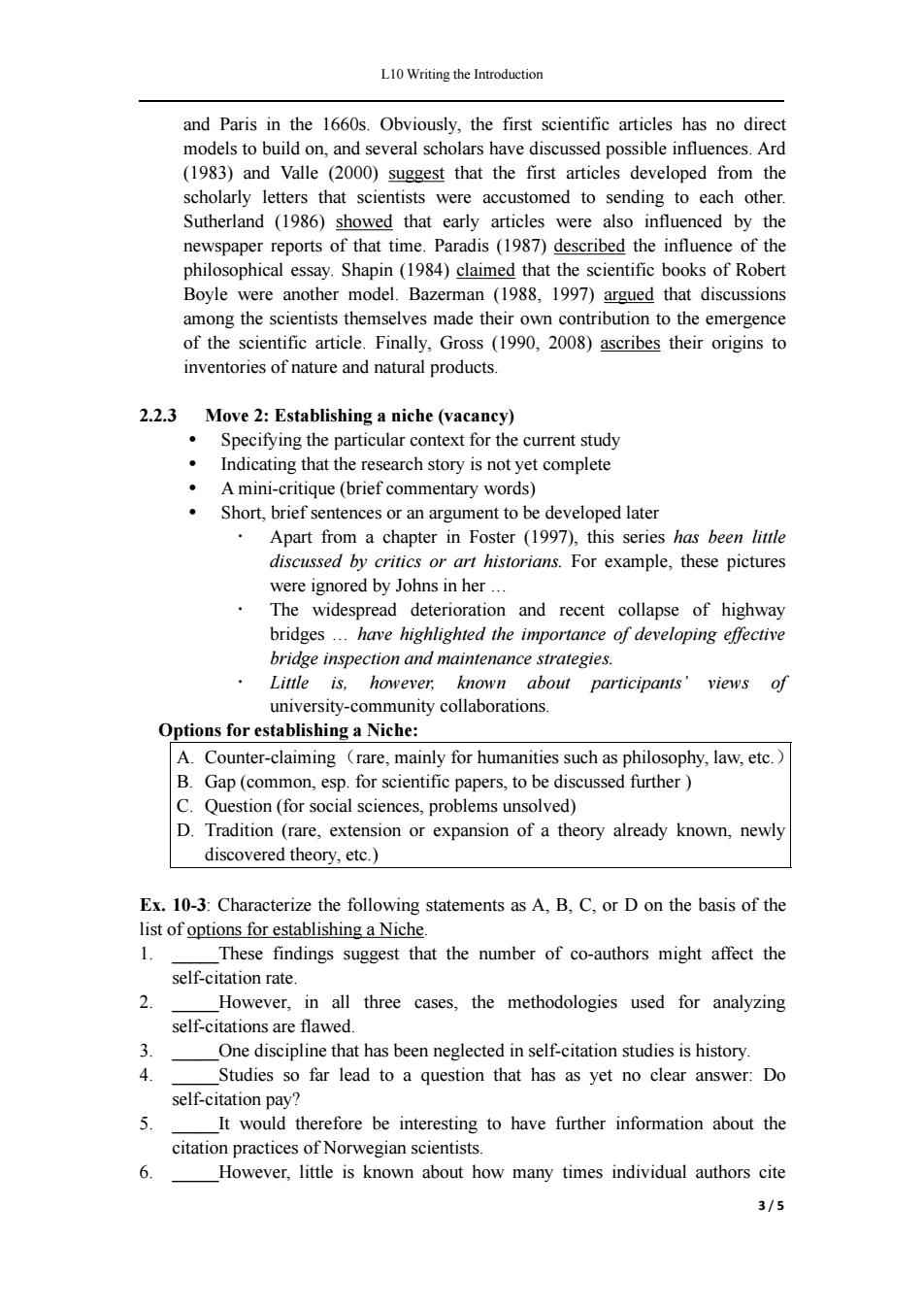
L10 Writing the Introduction and Paris in the 1660s.Obviously,the first scientific articles has no direct models to build on,and several scholars have discussed possible influences.Ard (1983)and Valle (2000)suggest that the first articles developed from the scholarly letters that scientists were accustomed to sending to each other. Sutherland (1986)showed that early articles were also influenced by the newspaper reports of that time.Paradis (1987)described the influence of the philosophical essay.Shapin (1984)claimed that the scientific books of Robert Boyle were another model.Bazerman (1988,1997)argued that discussions among the scientists themselves made their own contribution to the emergence of the scientific article.Finally,Gross (1990,2008)ascribes their origins to inventories of nature and natural products. 2.2.3 Move 2:Establishing a niche (vacancy) Specifying the particular context for the current study Indicating that the research story is not yet complete A mini-critique (brief commentary words) Short,brief sentences or an argument to be developed later Apart from a chapter in Foster (1997),this series has been little discussed by critics or art historians.For example,these pictures were ignored by Johns in her... The widespread deterioration and recent collapse of highway bridges...have highlighted the importance of developing effective bridge inspection and maintenance strategies. Little is,however,known about participants'views of university-community collaborations. Options for establishing a Niche: A.Counter-claiming (rare,mainly for humanities such as philosophy,law,etc. B.Gap(common,esp.for scientific papers,to be discussed further C.Question(for social sciences,problems unsolved) D.Tradition (rare,extension or expansion of a theory already known,newly discovered theory,etc.) Ex.10-3:Characterize the following statements as A,B,C,or D on the basis of the list of options for establishing a Niche. 1. These findings suggest that the number of co-authors might affect the self-citation rate. 2. However,in all three cases,the methodologies used for analyzing self-citations are flawed. 3. One discipline that has been neglected in self-citation studies is history. 4. Studies so far lead to a question that has as yet no clear answer:Do self-citation pay? 5 It would therefore be interesting to have further information about the citation practices of Norwegian scientists. However,little is known about how many times individual authors cite 3/5
L10 Writing the Introduction 3 / 5 and Paris in the 1660s. Obviously, the first scientific articles has no direct models to build on, and several scholars have discussed possible influences. Ard (1983) and Valle (2000) suggest that the first articles developed from the scholarly letters that scientists were accustomed to sending to each other. Sutherland (1986) showed that early articles were also influenced by the newspaper reports of that time. Paradis (1987) described the influence of the philosophical essay. Shapin (1984) claimed that the scientific books of Robert Boyle were another model. Bazerman (1988, 1997) argued that discussions among the scientists themselves made their own contribution to the emergence of the scientific article. Finally, Gross (1990, 2008) ascribes their origins to inventories of nature and natural products. 2.2.3 Move 2: Establishing a niche (vacancy) Specifying the particular context for the current study Indicating that the research story is not yet complete A mini-critique (brief commentary words) Short, brief sentences or an argument to be developed later Apart from a chapter in Foster (1997), this series has been little discussed by critics or art historians. For example, these pictures were ignored by Johns in her … The widespread deterioration and recent collapse of highway bridges … have highlighted the importance of developing ef ective bridge inspection and maintenance strategies. Little is, however, known about participants’ views of university-community collaborations. Options for establishing a Niche: A. Counter-claiming(rare, mainly for humanities such as philosophy, law, etc.) B. Gap (common, esp. for scientific papers, to be discussed further ) C. Question (for social sciences, problems unsolved) D. Tradition (rare, extension or expansion of a theory already known, newly discovered theory, etc.) Ex. 10-3: Characterize the following statements as A, B, C, or D on the basis of the list of options for establishing a Niche. 1. _____These findings suggest that the number of co-authors might affect the self-citation rate. 2. _____However, in all three cases, the methodologies used for analyzing self-citations are flawed. 3. _____One discipline that has been neglected in self-citation studies is history. 4. _____Studies so far lead to a question that has as yet no clear answer: Do self-citation pay? 5. _____It would therefore be interesting to have further information about the citation practices of Norwegian scientists. 6. _____However, little is known about how many times individual authors cite
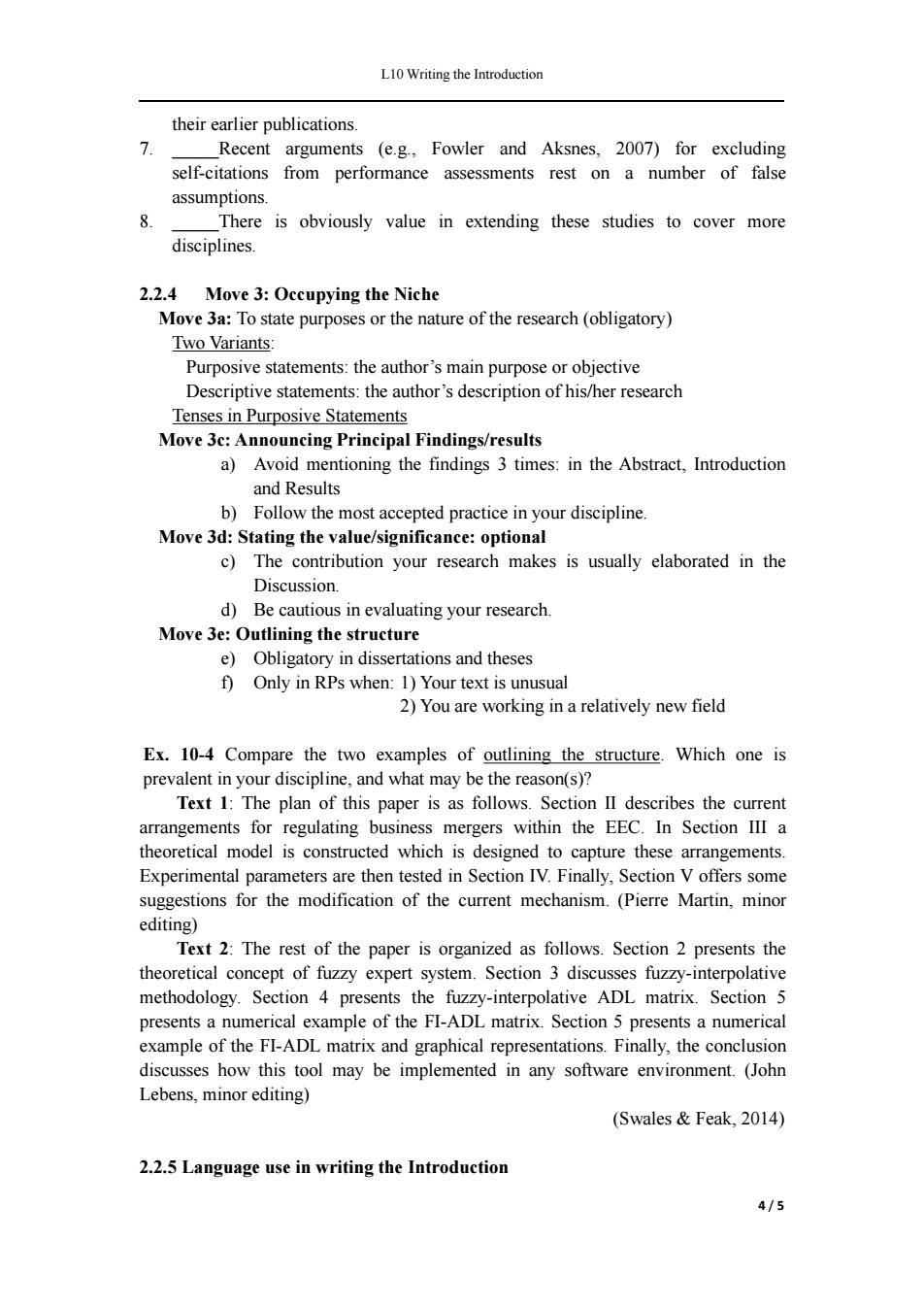
L10 Writing the Introduction their earlier publications. 7. Recent arguments (e.g.,Fowler and Aksnes,2007)for excluding self-citations from performance assessments rest on a number of false assumptions. 8 There is obviously value in extending these studies to cover more disciplines. 2.2.4 Move 3:Occupying the Niche Move 3a:To state purposes or the nature of the research (obligatory) Two Variants: Purposive statements:the author's main purpose or objective Descriptive statements:the author's description of his/her research Tenses in Purposive Statements Move 3c:Announcing Principal Findings/results a)Avoid mentioning the findings 3 times:in the Abstract,Introduction and Results b)Follow the most accepted practice in your discipline Move 3d:Stating the value/significance:optional c)The contribution your research makes is usually elaborated in the Discussion. d)Be cautious in evaluating your research. Move 3e:Outlining the structure e)Obligatory in dissertations and theses f)Only in RPs when:1)Your text is unusual 2)You are working in a relatively new field Ex.10-4 Compare the two examples of outlining the structure.Which one is prevalent in your discipline,and what may be the reason(s)? Text 1:The plan of this paper is as follows.Section II describes the current arrangements for regulating business mergers within the EEC.In Section III a theoretical model is constructed which is designed to capture these arrangements. Experimental parameters are then tested in Section IV.Finally,Section V offers some suggestions for the modification of the current mechanism.(Pierre Martin,minor editing) Text 2:The rest of the paper is organized as follows.Section 2 presents the theoretical concept of fuzzy expert system.Section 3 discusses fuzzy-interpolative methodology.Section 4 presents the fuzzy-interpolative ADL matrix.Section 5 presents a numerical example of the FI-ADL matrix.Section 5 presents a numerical example of the FI-ADL matrix and graphical representations.Finally,the conclusion discusses how this tool may be implemented in any software environment.(John Lebens,minor editing) (Swales Feak,2014) 2.2.5 Language use in writing the Introduction 4/5
L10 Writing the Introduction 4 / 5 their earlier publications. 7. _____Recent arguments (e.g., Fowler and Aksnes, 2007) for excluding self-citations from performance assessments rest on a number of false assumptions. 8. _____There is obviously value in extending these studies to cover more disciplines. 2.2.4 Move 3: Occupying the Niche Move 3a: To state purposes or the nature of the research (obligatory) Two Variants: Purposive statements: the author’s main purpose or objective Descriptive statements: the author’s description of his/her research Tenses in Purposive Statements Move 3c: Announcing Principal Findings/results a) Avoid mentioning the findings 3 times: in the Abstract, Introduction and Results b) Follow the most accepted practice in your discipline. Move 3d: Stating the value/significance: optional c) The contribution your research makes is usually elaborated in the Discussion. d) Be cautious in evaluating your research. Move 3e: Outlining the structure e) Obligatory in dissertations and theses f) Only in RPs when: 1) Your text is unusual 2) You are working in a relatively new field Ex. 10-4 Compare the two examples of outlining the structure. Which one is prevalent in your discipline, and what may be the reason(s)? Text 1: The plan of this paper is as follows. Section II describes the current arrangements for regulating business mergers within the EEC. In Section III a theoretical model is constructed which is designed to capture these arrangements. Experimental parameters are then tested in Section IV. Finally, Section V offers some suggestions for the modification of the current mechanism. (Pierre Martin, minor editing) Text 2: The rest of the paper is organized as follows. Section 2 presents the theoretical concept of fuzzy expert system. Section 3 discusses fuzzy-interpolative methodology. Section 4 presents the fuzzy-interpolative ADL matrix. Section 5 presents a numerical example of the FI-ADL matrix. Section 5 presents a numerical example of the FI-ADL matrix and graphical representations. Finally, the conclusion discusses how this tool may be implemented in any software environment. (John Lebens, minor editing) (Swales & Feak, 2014) 2.2.5 Language use in writing the Introduction
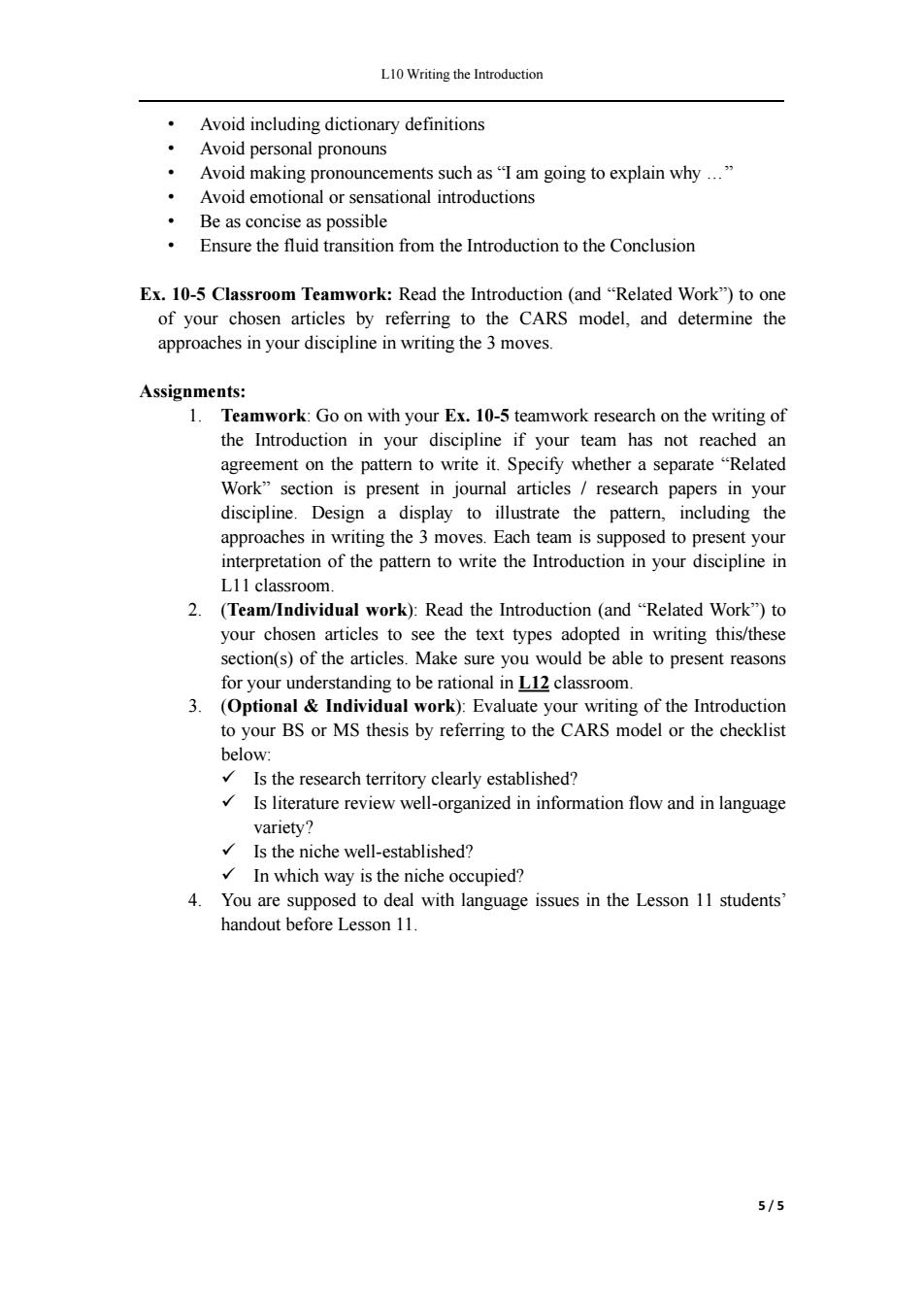
L10 Writing the Introduction Avoid including dictionary definitions Avoid personal pronouns Avoid making pronouncements such as"I am going to explain why..." Avoid emotional or sensational introductions Be as concise as possible Ensure the fluid transition from the Introduction to the Conclusion Ex.10-5 Classroom Teamwork:Read the Introduction (and "Related Work")to one of your chosen articles by referring to the CARS model,and determine the approaches in your discipline in writing the 3 moves. Assignments: 1.Teamwork:Go on with your Ex.10-5 teamwork research on the writing of the Introduction in your discipline if your team has not reached an agreement on the pattern to write it.Specify whether a separate "Related Work"section is present in journal articles research papers in your discipline.Design a display to illustrate the pattern,including the approaches in writing the 3 moves.Each team is supposed to present your interpretation of the pattern to write the Introduction in your discipline in L11 classroom. 2.(Team/Individual work):Read the Introduction (and "Related Work")to your chosen articles to see the text types adopted in writing this/these section(s)of the articles.Make sure you would be able to present reasons for your understanding to be rational in L12 classroom. 3.(Optional Individual work):Evaluate your writing of the Introduction to your BS or MS thesis by referring to the CARS model or the checklist below: Is the research territory clearly established? Is literature review well-organized in information flow and in language variety? Is the niche well-established? In which way is the niche occupied? 4.You are supposed to deal with language issues in the Lesson 11 students' handout before Lesson 11. 5/5
L10 Writing the Introduction 5 / 5 • Avoid including dictionary definitions • Avoid personal pronouns • Avoid making pronouncements such as “I am going to explain why …” • Avoid emotional or sensational introductions • Be as concise as possible • Ensure the fluid transition from the Introduction to the Conclusion Ex. 10-5 Classroom Teamwork: Read the Introduction (and “Related Work”) to one of your chosen articles by referring to the CARS model, and determine the approaches in your discipline in writing the 3 moves. Assignments: 1. Teamwork: Go on with your Ex. 10-5 teamwork research on the writing of the Introduction in your discipline if your team has not reached an agreement on the pattern to write it. Specify whether a separate “Related Work” section is present in journal articles / research papers in your discipline. Design a display to illustrate the pattern, including the approaches in writing the 3 moves. Each team is supposed to present your interpretation of the pattern to write the Introduction in your discipline in L11 classroom. 2. (Team/Individual work): Read the Introduction (and “Related Work”) to your chosen articles to see the text types adopted in writing this/these section(s) of the articles. Make sure you would be able to present reasons for your understanding to be rational in L12 classroom. 3. (Optional & Individual work): Evaluate your writing of the Introduction to your BS or MS thesis by referring to the CARS model or the checklist below: Is the research territory clearly established? Is literature review well-organized in information flow and in language variety? Is the niche well-established? In which way is the niche occupied? 4. You are supposed to deal with language issues in the Lesson 11 students’ handout before Lesson 11